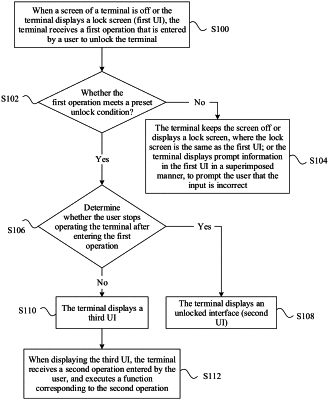| CPC G06V 40/1365 (2022.01) [G06F 3/0488 (2013.01); G06F 21/32 (2013.01); H04M 1/724631 (2022.02)] | 20 Claims |

|
1. A method implemented by a terminal, the method comprising:
receiving, by a fingerprint sensor of the terminal, a first operation from a user in an area of a screen of the terminal corresponding to the fingerprint sensor when the screen is off or is displaying a first user interface, wherein the first user interface comprises a lock screen of the terminal, and wherein the first operation comprises a fingerprint input of a finger;
determining, after the fingerprint input matches a preset fingerprint and by a processor and a touch sensor of the terminal, that the finger does not lift from the screen and that a first duration of the finger touching the screen is greater than a preset threshold duration;
displaying, in response to the fingerprint input matching the preset fingerprint, the finger not lifting from the screen, and the first duration being greater than the preset threshold duration, a second user interface, wherein the second user interface comprises one or more shortcuts, and wherein the one or more shortcuts comprises a first shortcut;
receiving, by the touch sensor, a second operation from the user when displaying the second user interface, wherein the second operation meets a preset condition;
determining, based on a layout of the one or more shortcuts in the second user interface and the second operation, a correspondence between the second operation and the first shortcut;
executing, in response to determining the correspondence, a function corresponding to the first shortcut;
receiving, by the touch sensor, a third operation from the user when displaying the second user interface, wherein the third operation does not meet the preset condition; and
displaying, in response to the third operation, an unlocked user interface, wherein the unlocked user interface is different with the second user interface.
|